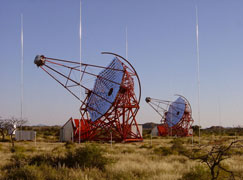
South African scientists make astronomy breakthrough
Wits scientists have found three extremely luminous gamma-ray sources in the Large Magellanic Cloud, a satellite dwarf galaxy of the Milky Way. The scientists are part of a multinational team of astronomers working on the High Energy Stereoscopic System (HESS) telescopes that have again demonstrated its excellent capabilities in searching for high-energy gamma rays.In the […]


Wits scientists have found three extremely luminous gamma-ray sources in the Large Magellanic Cloud, a satellite dwarf galaxy of the Milky Way.
The scientists are part of a multinational team of astronomers working on the High Energy Stereoscopic System (HESS) telescopes that have again demonstrated its excellent capabilities in searching for high-energy gamma rays.In the latest discovery using the HESS, the team has found the most powerful pulsar wind nebula; the most powerful supernova remnant; and a shell of 270 light years in diameter blown by multiple stars, and supernovae – a so-called superbubble.The discovery is announced in the latest edition of the scientific journal, Science, in a research paper titled: “The exceptionally powerful TeV ƴ- ray emitters in the Large Magellanic Cloud”, published on 23 January 2015.
Important discovery
“This is a very important breakthrough for the team,” says Professor Sergio Colafrancesco, DST/NRF SKA Research Chair in the Wits School of Physics. “It paves the way to study external galaxies with very high-E telescopes such as HESS and then later with the planned Cherenkov Telescope Array (CTA) in Namibia.”It will lead us to re-examine galaxy evolution and answer questions such as how high-E particles can affect the evolution of cosmic structures in the universe, principally galaxies, and the life cycles of matter in galaxies.”Very high-energy gamma rays are the best tracers of cosmic accelerators such as supernova remnants and pulsar wind nebulae – end-products of massive stars. There, charged particles are accelerated to extreme velocities. When these particles encounter light or gas in and around the cosmic accelerators, they emit gamma rays.Very high-energy gamma rays can be measured on Earth by observing the Cherenkov light emitted from the particle showers produced by incident gamma rays high up in the atmosphere using large telescopes with fast cameras.The Large Magellanic Cloud is a dwarf satellite galaxy of our Milky Way, located about 170.000 light years away and showing us its face. New, massive stars are formed at a high rate in the cloud, and it harbours numerous massive stellar clusters. The cloud’s supernova rate relative to its stellar mass is five times that of our galaxy.The youngest supernova remnant in the local group of galaxies, SN 1987A, is also a member of the cloud. Therefore, the HESS scientists dedicated significant observation to searching for very high-energy gamma rays from this cosmic object.
Star formation
HESS has observed the largest star-forming region within the cloud, called Tarantula Nebula, for a total of 210 hours. For the first time in a galaxy outside the Milky Way, individual sources of very high-energy gamma rays could be resolved: three extremely energetic objects of different type.The so-called superbubble 30 Dor C is the largest known X-ray-emitting shell and appears to have been created by several supernovae and strong stellar winds. Superbubbles are broadly discussed as (complementary or alternative to individual supernova remnants) factories where the galactic cosmic rays are produced.The HESS results demonstrate that the bubble is a source of, and filled by, highly energetic particles. The superbubble represents a new class of sources in the very high-energy regime.Observed at the limits of detectability, and partially overlapping with each other, these new sources challenged the HESS scientists. The discoveries were possible following the development of advanced methods of interpreting the Cherenkov images captured by the telescopes.The new HESS II 28m telescope will boost the performance of the HESS telescope system, and in the more distant future the planned Cherenkov Telescope Array (CTA) will provide even deeper and higher-resolution gamma-ray images of the Large Magellanic Cloud – in the plans for science with CTA, the satellite galaxy is already identified as a Key Science Project deserving special attention.
International team
The HESS telescope is operated by an international collaboration of scientists with a strong involvement by South African universities, in particular Wits and North West universities, and the universities of the Free State and Johannesburg.Wits physicists are particularly involved in data analysis techniques, the development of theoretical interpretation tools of both extragalactic and galactic sources, and in the operational shifts at the telescope location in Namibia.
By: University of the Witwatersrand
Source: www.southafrica.info
